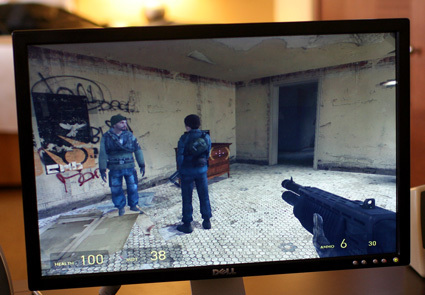Intel to improve video, vertex shading in its IGCs
San Francisco (CA) - Intel is trying to convince entry-level gamers to accept integrated graphics with a new hardware vertex shader for its G965 graphics chip. At the Game Developers Conference in San Francisco, the company showed off some demos of popular first person shooters on the chip and also challenged journalists to pick out the integrated graphics-powered computer against a computer running a discrete card.
Call of Duty 2 with the beta G965 hardware vertex shader driver
Nick Knupffer, PR Manager for Intel, showed off a beta hardware vertex driver that should speed up many first-person shooters. Time demos of Call of Duty 2 and Half-Life 2 Episode One were played and we saw that the G965 chip averaged around 30 to 60 frames per second. We did notice a few cases of slowness during some of the more complicated scenes, but Knupffer told us that this "Four dollar" integrated solution would still please most people.
Half-Life 2 Episode One demo
Knupffer was quick to point out that integrated still won't replace discrete graphics cards anytime soon and added, "People who need extra power will still buy a discrete card." He also said that Intel is positioning the G965 graphics chip at running the most popular games, not necessarily the most graphically intensive games.
But the G965 isn't just getting a breath of fresh air on the games front. Company reps also showed us improved video de-interlacing with its ClearVideo technology. In a side-by-side comparison with a similarly configured computer running an ATI X1600 chip, an Intel integrated graphics-powered computer showed less jaggies and smooth playback in the HQV flag demo.
Knupffer told us that premium video players like Cyberlink can call up special routines in the chip to enhance video playback. We were quite surprised at how prominent the jaggies were on the discrete ATI X1600-powered machine and we quickly verified that it was using the latest Catalyst drivers and that the video file was the same format, resolution and size.
Get Tom's Hardware's best news and in-depth reviews, straight to your inbox.
The new driver is in the final testing stages and Intel plans on releasing it on the company website soon.
As previously reported, the G965 chipset will be supporting DirectX 10.
Humphrey Cheung was a senior editor at Tom's Hardware, covering a range of topics on computing and consumer electronics. You can find more of his work in many major publications, including CNN and FOX, to name a few.

